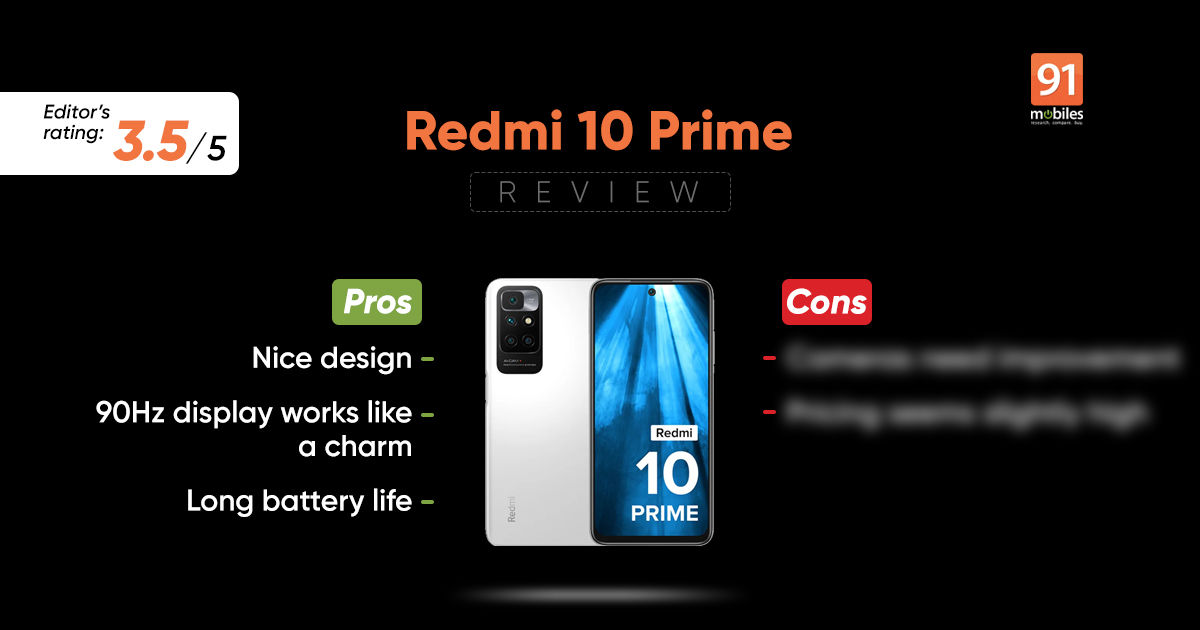Xiaomi is India’s largest smartphone maker by way of whole models shipped and its Redmi lineup may be credited for that. Whereas its signature Notice collection has crossed the Rs 15,000 mark by way of pricing, there are nonetheless a number of units being offered by the OEM that tie Xiaomi to its price range roots. Final yr’s Redmi 9 Prime (evaluation), beginning at Rs 9,999, was one such system. Nevertheless, the newly-launched successor which comes within the type of the Redmi 10 Prime has bumped up the value to Rs 12,499 for its 4GB + 64GB model. For the first shooter, you now get a brand new 50MP sensor, whereas the processing is dealt with by the brand new MediaTek Helio G88 chipset. On this evaluation, let’s learn how related the telephone is when put towards the corporate’s personal Redmi Notice 10 (evaluation) and rivals just like the Realme 8 (evaluation).
Desk of Contents
Verdict
The Redmi 10 Prime gives a much bigger battery, barely sooner charging, a brand new major digital camera and respectable design language over the earlier iteration of the system. Nevertheless, other than the show, there’s little or no in the way in which of suggestions for the system over Redmi’s Notice 10 collection which is priced simply barely increased.
The lowdown
I’ve to offer credit score to Xiaomi’s product design staff for developing with the beautiful design language on the Redmi 10 Prime. Whereas the development materials stays polycarbonate, the shiny touch-up and color gradient scheme have me impressed. The massive digital camera housing prominently options the signature 50MP digital camera on the high which Xiaomi has been bragging about quite a bit. The corporate has managed to truly shave off a couple of millimetres in thickness over the earlier iteration whereas rising the battery capability to six,000mAh. The telephone’s weight additionally feels effectively balanced, whereas the curve across the edges offers a agency grip. The headphone jack finds its approach on the high of the telephone in typical Xiaomi vogue, whereas the USB C port and speaker grille are on the backside. On that observe, Xiaomi has used the earpiece as a secondary speaker to offer stereo sound, which I very a lot recognize. The fingerprint sensor has been built-in into the facility button on the aspect.
As for the system’s entrance, Xiaomi has been variety sufficient to combine a 90Hz IPS LCD panel, however with a sizeable gap punch on the high. Bezels have been largely saved slim across the show for a greater viewing expertise. The decision is FHD+, though that could be a naked minimal you’ll be able to anticipate at this worth level. The brightness ranges are respectable for out of doors utilization and the off-axis color shift shouldn’t be as distinguished as on a couple of different LCD panels by different OEMs within the price range class. The color saturation may be customised within the show settings together with toggles for Studying mode, Darkish mode and adjusting the refresh fee. As for OTT content material, the system’s WideVine L1 certification can have you lined for HD viewing.
There are a complete of 4 cameras on the again of the telephone, which incorporates the 50MP major digital camera, supported by an 8MP ultra-wide, 2MP depth, and 2MP macro shooters. On the entrance, you get an 8MP selfie shooter housed within the punch-hole. Listed here are some element on how the cameras fare.
- Daylight photographs appeared good, with ample element and fairly good dynamic vary. The colors had been practical and vivid with a tinge of saturation in reds and blues. The shutter velocity is quick, however the autofocus is a bit slower than I’d desire, which resulted in blurry photographs of fast-moving objects. Different facets of the shooter included a UHD 50MP mode which permits cropping into photographs and making finer particulars look higher. Publicity may be very a lot managed even in extraordinarily vibrant sunny circumstances.
- Low gentle pictures wasn’t very spectacular, which is stunning since Xiaomi has maybe the perfect night time pictures capabilities within the price range phase. The main target occasions are usually not that nice and there’s a lot of softness to the photographs across the centre of the body. Noise ranges are excessive even with assisted road lighting and the devoted Night time mode not working any wonders both. Portrait mode photographs are a lot better as compared with good outlining of the topic and a pleasant blur that goes simple on the attention. Macro mode washes out a number of the colors however is sweet with detailing, a minimum of as a lot as a 2MP sensor is able to getting. The ultra-wide digital camera creates a warped look on the aspect and color temperatures are sometimes at odds with the first shooter.
- The selfie digital camera is nothing spectacular however so far as picture high quality and facial detailing go, the sensor nearly will get the job accomplished. Total, I do really feel barely upset this time round within the optics of the system, particularly when the Redmi Notice 10 is a lot more proficient at higher picture processing whereas costing nearly Rs 1,500 extra.
The MediaTek Helio G88 powering the Redmi 10 Prime is a brand new chipset designed by the Taiwanese silicone big as an improve to the Helio G85 already current on a couple of Xiaomi telephones. Nevertheless, the G88 doesn’t supply any vital efficiency positive aspects over the G85. So far as processing goes, the Helio G88 is fairly commonplace difficulty for the value. It’s good at multi-tasking and environment friendly sufficient to run heavy apps with out drawing a complete lot of energy from the battery. It’s prudent for me to level out that what the Redmi 10 Prime can supply by way of efficiency may also be obtained from the cheaper Narzo 30A. Each telephones can run equally demanding duties akin to Battlegrounds Cell India on the identical graphics settings. Apart from that you simply get 4GB RAM and 64GB of non-expandable inner storage because the beginning variant which appears rather less for the value. The audio system sound impressively good and I didn’t run into any issues with the telephone’s 4G capabilities on Jio’s Noida community.
On the software program entrance, the system runs Xiaomi’s proprietary MIUI 12.5 pores and skin over Android 11. There are cues from iOS, as a swipe down from the left bringing in notifications whereas on the suitable brings down fast settings. A number of parts of Android 12 are additionally in play such because the prominently massive Bluetooth, Wi-Fi, Flashlight, and Cell information icons. You’ll be able to take a look at the entire record of options in my colleague’s evaluation of the POCO F3 GT. The underside line is that Xiaomi has labored quite a bit to alter operability on its Android pores and skin and most of it’s to my liking.
Battery-wise the telephone is packing in a 6,000mAh cell which is supported by 18W quick charging. With the chipset not being too power-hungry, the telephone can simply final for about two days straight on a single cost. My utilization with the system has been restricted to watching the newest season of Cash Heist on Netflix, checking my social media accounts, watching YouTube and a few hours of BGMI gaming. By the tip of the second day, I had about 10 p.c juice nonetheless left which speaks volumes concerning the system’s battery administration. Nevertheless, charging up the telephone takes a little bit of time, near 150 minutes.
Last Verdict
The Redmi 10 Prime has all of the specs you’ll be able to anticipate from a price range Redmi system akin to a big battery, respectable efficiency and a excessive utility show, although the taking pictures prowess does depart one wanting. Nevertheless, pricing the system so near the Redmi Notice 10, which is a greater telephone for the value, appears odd. My evaluation unit, which comes with 6GB RAM and 128GB storage is priced at Rs 14,999 which does appear on the upper aspect. I feel the Redmi 10 Prime is an honest telephone, however whether it is higher cameras and efficiency you need, then the Redmi Notice 10S or the Realme 8 could be safer bets.
Editor’s ranking: 3.5 / 5
Execs
- Good design
- 90Hz show works like a allure
- Lengthy battery life
Cons
- Cameras have to be improved
- Pricing appears barely excessive




